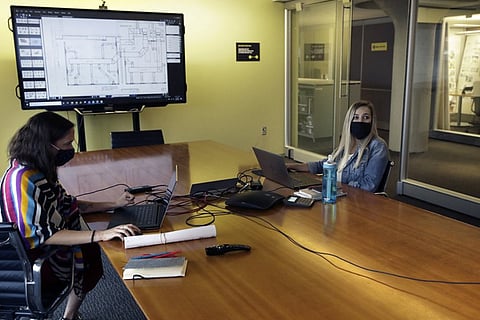

Chennai
“The one-way paths take me a little out of the way, but it was easy to get used to,” said Stephanie Jones, an interior designer with the company. “It actually gives me the opportunity to see more people and say a quick hello when I might have just walked directly to my desk before.”
Around the US, office workers sent home when the coronavirus took hold in March are returning to the world of cubicles and conference rooms and facing certain adjustments: masks, staggered shifts, spaced-apart desks, daily questions about their health, closed break rooms and sanitiser everywhere. For some at least, there are also advantages, including the opportunity to share chitchat with colleagues again or the ability to get more work done. Employers in some cases are requiring workers to come back to the office, but most, like Bergmeyer, are letting the employees decide what to do, at least for now. Some firms say the risks and precautions are worth it to boost productivity and move closer to normal.
It is meagre trend so far: Real estate trade group NAIOP Massachusetts estimated the occupancy rate for many office towers in downtown Boston at around 5%, and 10% to 20% in the suburbs. That echoes what is happening in other cities. In New York, real estate firm CBRE said the offices it manages have a 7% occupancy rate in Manhattan and nearly 30% in the suburbs.
Bergmeyer began bringing people back in June in stages. It is now in Phase Three, with 60% of the staff back in the office but split into two groups: Half come in on Mondays, Wednesdays and Fridays, the other half on Tuesdays and Thursdays.
Employees are asked to report any symptoms to a human resources director who can work with them on getting tested and quarantining themselves. Jones elected to come back in the second wave, in late June.
“I found that I was surprisingly more productive than I thought I would be working from home, but ultimately decided to come back. I live alone, and I was missing the social interaction,” she said. She also missed the space in the office, her double computer monitors and other advantages.
“I’m an interior designer, and I’m used to picking finishes and materials with a whole resource library here I didn’t have access to,” she said. “Suddenly I had to be ordering everything to my home, and it was taking over.” At first, the one-way aisles meant that those who sat just past the restrooms had to walk all the way around the office to get to them. So Bergmeyer added another path down the middle. But if you go to the kitchen, Jones said, you have to keep walking around the circle to get back to your desk. The natural light in the office was too bright for some Zoom calls, so the company has been experimenting with audio, lighting, acoustics and backdrops in several new dedicated “Zoom rooms.” All in all, Jones said, “it’s great to come back in on a part-time basis on my own terms.”
Stephan Meier, a business professor at Columbia University, expressed skepticism about bringing workers back in the midst of the outbreak, which has been blamed for over 5 million confirmed infections and nearly 170,000 deaths in the U.S. Most firms have discovered that people can work effectively remotely, he said. “The safety of your workers has to be top priority,“ he said.
As virus cases surge in many states, some companies have found that reopening has led to re-closing. The Blue Sky advertising agency in Atlanta began reopening in May in stages, reconfiguring its open-plan workspace by spreading out tables, installing plastic partitions and establishing a limit of 10 people in the office at any one time out of a workforce of 25, and caps on how many could be in certain rooms.
Associated Press
Visit news.dtnext.in to explore our interactive epaper!
Download the DT Next app for more exciting features!
Click here for iOS
Click here for Android